[1] ORYAN A, ALIDADI S. Reconstruction of radial bone defect in rat by calcium silicate biomaterials. Life Sci. 2018;201:45-53.
[2] 刘建国,周宏博.医用β钛合金的性能研究现状[J].口腔医学研究, 2020,36(6):501-508.
[3] ZHAO QM, LI XK, GUO S, et al. Osteogenic activity of a titanium surface modified with silicon-doped titanium dioxide. Mater Sci Eng C Mater Biol Appl. 2020;110:110682.
[4] 张文毓.生物医用金属材料研究现状与应用进展[J].金属世界, 2020(1):21-27.
[5] KHARE D, BASU B, DUBEY AK. Electrical stimulation and piezoelectric biomaterials for bone tissue engineering applications. Biomaterials. 2020;258:120280.
[6] QI T, WENG J, YU F, et al. Insights into the role of magnesium ions in affecting osteogenic differentiation of mesenchymal stem cells. Biol Trace Elem Res. 2021;199(2):559-567.
[7] Onder S, Calikoglu-Koyuncu AC, Kazmanli K, et al. Magnesium doping on TiN coatings affects mesenchymal stem cell differentiation and proliferation positively in a dose-dependent manner. Biomed Mater Eng. 2018;29(4):427-438.
[8] 庞新岗,李永刚,包倪荣,等.骨代谢主要信号通路及信号分子的研究进展[J].基础医学与临床,2018,38(12):1799-1803.
[9] 陈伟健,晋大祥,谢炜星,等.Runx2基因参与骨代谢相关通路的研究进展[J].中国骨质疏松杂志,2018,24(4):557-560.
[10] ZHOU Y, SNEAD ML, TAMERLER C. Bio-inspired hard-to-soft interface for implant integration to bone. Nanomedicine. 2015;11(2):431-434.
[11] HONG H, XU G, DENG H, et al. Concentration-dependent regulation of tial6v4 particles on the osteogenesis potential of human bone marrow mesenchymal stem cells. Biol Trace Elem Res. 2020;195(2):445-453.
[12] BERGLUND IS, DIRR EW, RAMASWAMY V, et al. The effect of Mg-Ca-Sr alloy degradation products on human mesenchymal stem cells. J Biomed Mater Res B Appl Biomater. 2018;106(2):697-704.
[13] GU Y, ZHANG J, ZHANG X, et al. Three-dimensional printed mg-doped β-tcp bone tissue engineering scaffolds: effects of magnesium ion concentration on osteogenesis and angiogenesis in vitro. Tissue Eng Regen Med. 2019;16(4):415-429.
[14] TSAO YT, SHIH YY, LIU YA, et al. Knockdown of SLC41A1 magnesium transporter promotes mineralization and attenuates magnesium inhibition during osteogenesis of mesenchymal stromal cells. Stem Cell Res Ther. 2017;8(1):39.
[15] HUNG CC, CHAYA A, LIU K, et al. The role of magnesium ions in bone regeneration involves the canonical Wnt signaling pathway. Acta Biomater. 2019;98:246-255.
[16] WANG Y, GENG Z, HUANG Y, et al. Unraveling the osteogenesis of magnesium by the activity of osteoblasts in vitro. J Mater Chem B. 2018;6(41):6615-6621.
[17] SHI LY, WANG A, ZANG FZ, et al. Tantalum-coated pedicle screws enhance implant integration. Colloids Surf B Biointerfaces. 2017;160: 22-32.
[18] KOBAYASHI Y, UEHARA S, KOIDE M, et al. The regulation of osteoclast differentiation by Wnt signals. Bonekey Rep. 2015;4:713.
[19] JING D, ZHAI M, TONG S, et al. Pulsed electromagnetic fields promote osteogenesis and osseointegration of porous titanium implants in bone defect repair through a Wnt/β-catenin signaling-associated mechanism. Sci Rep. 2016;6:32045.
[20] JING D, LI F, JIANG M, et al. Pulsed electromagnetic fields improve bone microstructure and strength in ovariectomized rats through a Wnt/Lrp5/β-catenin signaling-associated mechanism. PLoS One. 2013;8(11):e79377.
[21] JING D, CAI J, WU Y, et al. Pulsed electromagnetic fields partially preserve bone mass, microarchitecture, and strength by promoting bone formation in hindlimb-suspended rats. J Bone Miner Res. 2014; 29(10):2250-2261.
[22] 周雷,王明海.成骨分化相关信号通路的研究进展[J].临床医学进展,2017,7(4):235-241.
[23] WANG C, LIN K, CHANG J, et al. Osteogenesis and angiogenesis induced by porous β-CaSiO(3)/PDLGA composite scaffold via activation of AMPK/ERK1/2 and PI3K/Akt pathways. Biomaterials. 2013;34(1): 64-77.
[24] KIM JA, YUN HS, CHOI YA, et al. Magnesium phosphate ceramics incorporating a novel indene compound promote osteoblast differentiation in vitro and bone regeneration in vivo. Biomaterials. 2018;157:51-61.
[25] DOU X, WEI X, LIU G, et al. Effect of porous tantalum on promoting the osteogenic differentiation of bone marrow mesenchymal stem cells in vitro through the MAPK/ERK signal pathway. J Orthop Translat. 2019;19:81-93.
[26] CAO H, ZHANG W, MENG F, et al. Osteogenesis catalyzed by titanium-supported silver nanoparticles. ACS Appl Mater Interfaces. 2017;9(6):5149-5157.
[27] ZHU D, SU Y, YOUNG ML, et al. Biological responses and mechanisms of human bone marrow mesenchymal stem cells to zn and mg biomaterials. ACS Appl Mater Interfaces. 2017;9(33):27453-27461.
[28] LI M, HE P, WU Y, et al. Stimulatory effects of the degradation products from Mg-Ca-Sr alloy on the osteogenesis through regulating ERK signaling pathway. Sci Rep. 2016;6:32323.
[29] ZHAO L, WANG H, HUO K, et al. The osteogenic activity of strontium loaded titania nanotube arrays on titanium substrates. Biomaterials. 2013;34(1):19-29.
[30] HUO K, ZHANG X, WANG H, et al. Osteogenic activity and antibacterial effects on titanium surfaces modified with Zn-incorporated nanotube arrays. Biomaterials. 2013;34(13):3467-3478.
[31] ARAÚJO-GOMES N, ROMERO-GAVILÁN F, GARCÍA-ARNÁEZ I, et al. Osseointegration mechanisms: a proteomic approach. J Biol Inorg Chem. 2018;23(3):459-470.
[32] YAN Y, WEI Y, YANG R, et al. Enhanced osteogenic differentiation of bone mesenchymal stem cells on magnesium-incorporated titania nanotube arrays. Colloids Surf B Biointerfaces. 2019;179:309-316.
[33] ZHAO M, DAI Y, LI X, et al. Evaluation of long-term biocompatibility and osteogenic differentiation of graphene nanosheet doped calcium phosphate-chitosan AZ91D composites. Mater Sci Eng C Mater Biol Appl. 2018;90:365-378.
[34] WANG Z, LIU Q, LIU C, et al. Mg2+ in β-TCP/Mg-Zn composite enhances the differentiation of human bone marrow stromal cells into osteoblasts through MAPK-regulated Runx2/Osx. J Cell Physiol. 2020;235(6):5182-5191.
[35] JIANG T, GUO L, NI S, et al. Upregulation of cell proliferation via Shc and ERK1/2 MAPK signaling in SaOS-2 osteoblasts grown on magnesium alloy surface coating with tricalcium phosphate. J Mater Sci Mater Med. 2015;26(4):158.
[36] ZHAO Q, YI L, JIANG L, et al. Surface functionalization of titanium with zinc/strontium-doped titanium dioxide microporous coating via microarc oxidation. Nanomedicine. 2019;16:149-161.
[37] CHOUIRFA H, BOULOUSSA H, MIGONNEY V, et al. Review of titanium surface modification techniques and coatings for antibacterial applications. Acta Biomater. 2019;83:37-54.
[38] ZHAO QM, LI XK, GUO S, et al. Osteogenic activity of a titanium surface modified with silicon-doped titanium dioxide. Mater Sci Eng C Mater Biol Appl. 2020;110:110682.
[39] GITTENS RA, OLIVARES-NAVARRETE R, HYZY SL, et al. Superposition of nanostructures on microrough titanium-aluminum-vanadium alloy surfaces results in an altered integrin expression profile in osteoblasts. Connect Tissue Res. 2014;55 Suppl 1(1):164-168.
[40] LIU Q, LIMTHONGKUL W, SIDHU G, et al. Covalent attachment of P15 peptide to titanium surfaces enhances cell attachment, spreading, and osteogenic gene expression. J Orthop Res. 2012;30(10):1626-1633.
[41] WANG J, MA XY, FENG YF, et al. Magnesium ions promote the biological behaviour of rat calvarial osteoblasts by activating the PI3K/Akt signalling pathway. Biol Trace Elem Res. 2017;179(2):284-293.
[42] WU SS, LIANG QH, LIU Y, et al. Omentin-1 Stimulates Human Osteoblast Proliferation through PI3K/Akt Signal Pathway. Int J Endocrinol. 2013; 2013:368970.
[43] WU CM, CHEN PC, LI TM, et al. Si-Wu-tang extract stimulates bone formation through PI3K/Akt/NF-κB signaling pathways in osteoblasts. BMC Complement Altern Med. 2013;13:277.
[44] WANG Z, WANG X, PEI J, et al. Degradation and osteogenic induction of a SrHPO4-coated Mg-Nd-Zn-Zr alloy intramedullary nail in a rat femoral shaft fracture model. Biomaterials. 2020;247:119962.
[45] XU X, LIU X, YANG Y, et al. Resveratrol inhibits the development of obesity-related osteoarthritis via the TLR4 and PI3K/Akt signaling pathways. Connect Tissue Res. 2019;60(6):571-582.
[46] ZHANG X, ZU H, ZHAO D, et al. Ion channel functional protein kinase TRPM7 regulates Mg ions to promote the osteoinduction of human osteoblast via PI3K pathway: in vitro simulation of the bone-repairing effect of Mg-based alloy implant. Acta Biomater. 2017;63:369-382.
[47] CHEN Y, ROOHANI-ESFAHANI SI, LU Z, et al. Zirconium ions up-regulate the BMP/Smad signaling pathway and promote the proliferation and differentiation of human osteoblasts. PLoS One. 2015;10(1):e0113426.
[48] LU Z, WANG G, ROOHANI-ESFAHANI I, et al. Baghdadite ceramics modulate the cross talk between human adipose stem cells and osteoblasts for bone regeneration. Tissue Eng Part A. 2014;20(5-6): 992-1002.
[49] Zhang X, Chen Q, Mao X. Magnesium enhances osteogenesis of BMSCs by tuning osteoimmunomodulation. Biomed Res Int. 2019; 2019:7908205.
[50] Li M, Wan P, Wang W, et al. Regulation of osteogenesis and osteoclastogenesis by zoledronic acid loaded on biodegradable magnesium-strontium alloy. Sci Rep. 2019;9(1):933.
[51] Kulkarni RN, Bakker AD, Everts V, et al. Inhibition of osteoclastogenesis by mechanically loaded osteocytes: involvement of MEPE. Calcif Tissue Int. 2010;87(5):461-468. |
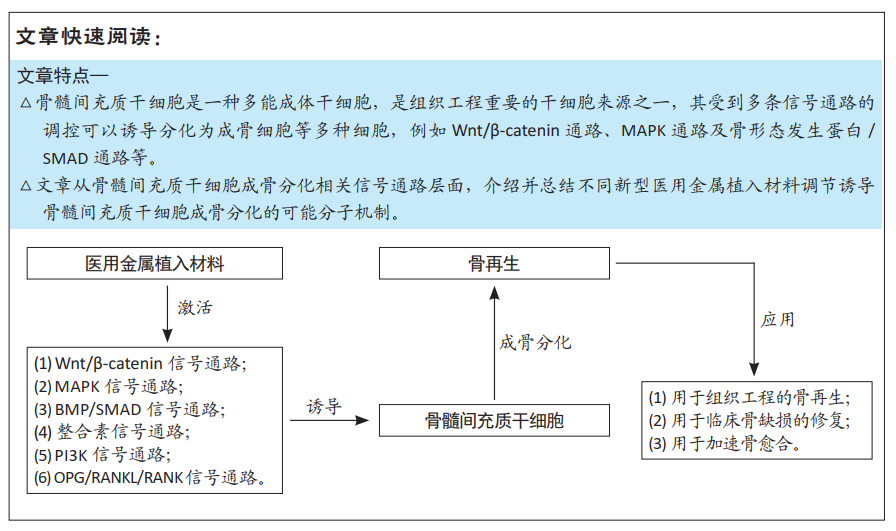 文题释义:
文题释义:
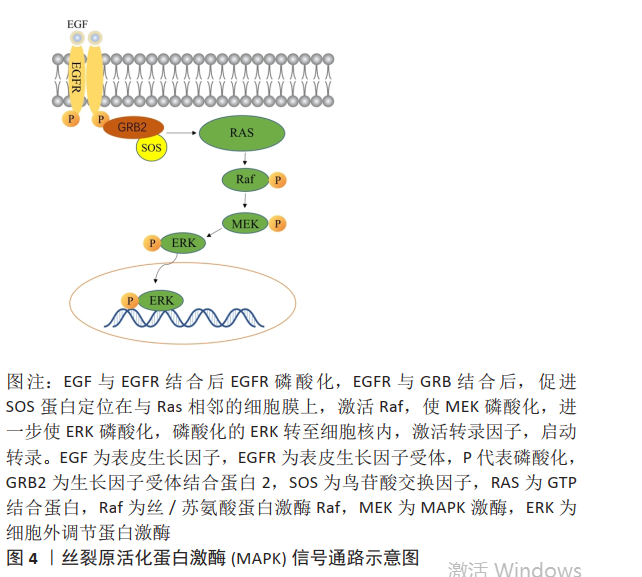
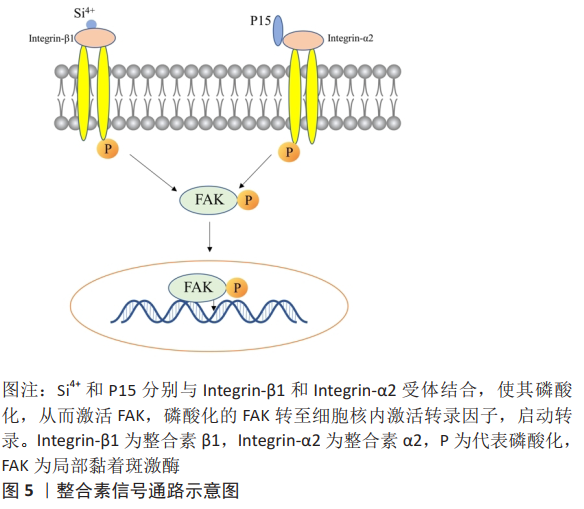

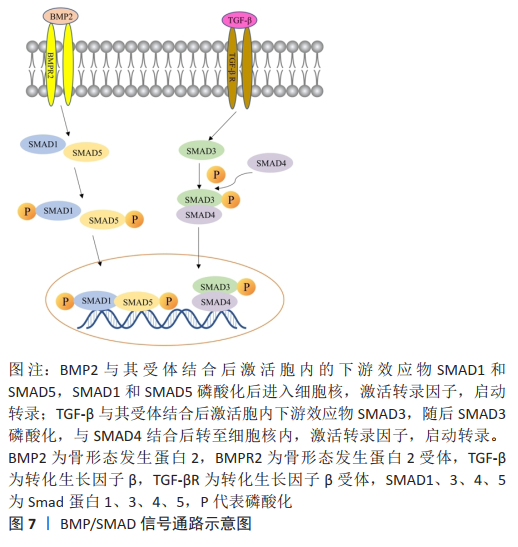
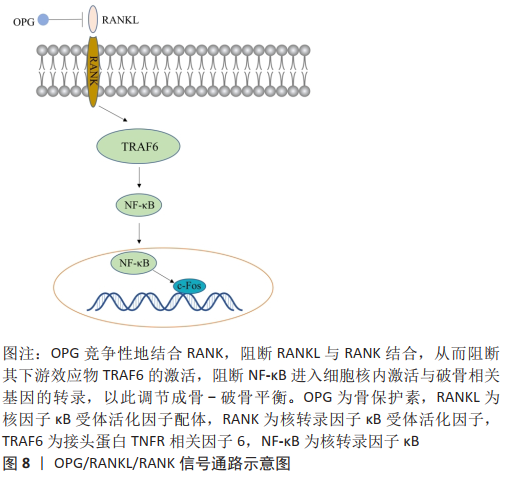
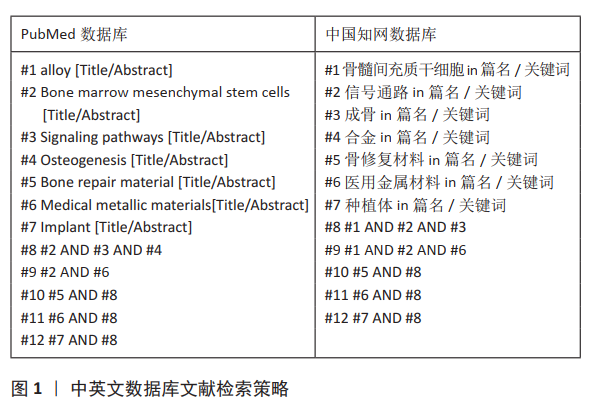
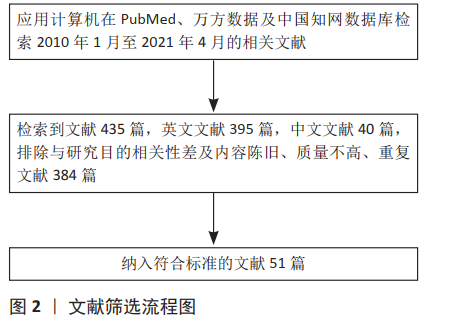
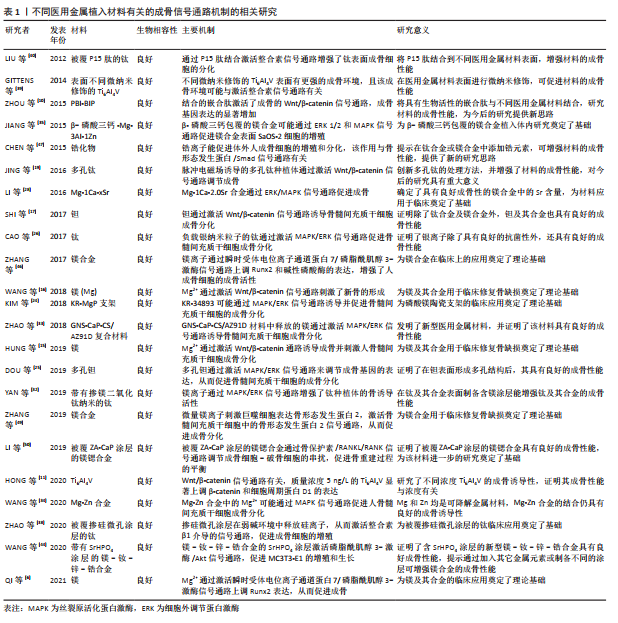 3.2 综述的创新性 既往此类综述都是对骨髓间充质干细胞成骨分化相关信号通路进行总结分析,且很少有综述对医用金属植入材料诱导骨髓间充质干细胞的相关信号通路进行总结。作者查阅了相关文献后,总结近年来不同的新型医用金属植入材料诱导骨髓间充质干细胞所涉及的相关信号通路,讨论分析了不同材料调控并诱导骨髓间充质干细胞成骨分化的可能分子机制。
3.2 综述的创新性 既往此类综述都是对骨髓间充质干细胞成骨分化相关信号通路进行总结分析,且很少有综述对医用金属植入材料诱导骨髓间充质干细胞的相关信号通路进行总结。作者查阅了相关文献后,总结近年来不同的新型医用金属植入材料诱导骨髓间充质干细胞所涉及的相关信号通路,讨论分析了不同材料调控并诱导骨髓间充质干细胞成骨分化的可能分子机制。